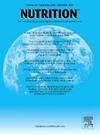Extracellular water-to-total body water ratio and its relationship with activities of daily living in older inpatients in a convalescent setting
IF 3
3区 医学
Q2 NUTRITION & DIETETICS
引用次数: 0
Abstract
Objective
The aim of this study was to examine whether the extracellular water-to-total body water ratio (ECW/TBW) is associated with activities of daily living (ADLs) in older inpatients in a convalescent setting, and to determine whether ECW/TBW or skeletal muscle mass index (SMI) is more strongly correlated with ADLs.
Design
Retrospective study.
Setting and Participants
A total of 196 older inpatients (86 males and 110 females) admitted to a convalescent rehabilitation ward were included.
Methods
The primary outcomes were ECW/TBW and ADLs at admission. ECW/TBW and SMI were measured using segmental multifrequency bioelectrical impedance analysis. ADLs were assessed with the Functional Independence Measure (FIM) motor score. Multiple linear regression analysis, adjusted for confounding factors, was performed to determine whether ECW/TBW was independently and significantly associated with FIM motor scores in male and female groups.
Results
The study cohort included 56 patients with stroke (28.6%), 45 with musculoskeletal disease (23.0%), and 95 with hospital-associated deconditioning (48.5%). The median (interquartile range; IQR) age was 81.0 (75.0–88.0) years in males and 87.0 (81.8–90.3) years in females. The median (IQR) ECW/TBW was 0.412 (0.404–0.421) in males and 0.419 (0.411–0.427) in females. The median (IQR) FIM motor score was 19.5 (14.0–39.0) in males and 23.0 (14.0–42.0) in females. In males, ECW/TBW was negatively associated with FIM motor scores, whereas SMI was positively associated. In females, ECW/TBW was negatively associated with FIM motor scores, whereas SMI was not significantly related.
Conclusions and Implications
ECW/TBW was negatively associated with ADLs in older inpatients in a convalescent setting in both sexes. Although SMI was positively associated with ADLs in males, no such relationship was observed in females. These findings suggest that monitoring ECW/TBW may be a useful approach for evaluating ADLs in older inpatients.
康复期老年住院患者细胞外水与全身水的比值及其与日常生活活动的关系
目的探讨老年住院康复患者细胞外水/全身水比(ECW/TBW)是否与日常生活活动(adl)相关,并确定ECW/TBW或骨骼肌质量指数(SMI)与adl的相关性是否更强。DesignRetrospective研究。环境和参与者共纳入196名老年住院患者(86名男性,110名女性)。方法主要指标为入院时的ECW/TBW和adl。采用分段多频生物电阻抗法测量ECW/TBW和SMI。用功能独立测量(FIM)运动评分评估ADLs。对混杂因素进行校正后的多元线性回归分析,以确定男女两组的ECW/TBW是否与FIM运动评分独立且显著相关。结果研究队列包括56例脑卒中患者(28.6%),45例肌肉骨骼疾病患者(23.0%),95例医院相关疾病患者(48.5%)。年龄中位数(四分位间距;IQR)为男性81.0(75.0-88.0)岁,女性87.0(81.8-90.3)岁。男性ECW/TBW的中位数(IQR)为0.412(0.404-0.421),女性为0.419(0.411-0.427)。男性FIM运动评分中位数(IQR)为19.5分(14.0 ~ 39.0分),女性为23.0分(14.0 ~ 42.0分)。在男性中,ECW/TBW与FIM运动评分呈负相关,而SMI呈正相关。在女性中,ECW/TBW与FIM运动评分呈负相关,而SMI无显著相关。结论和意义secw /TBW与老年康复住院患者adl呈负相关。虽然在男性中,重度精神分裂症与adl呈正相关,但在女性中没有观察到这种关系。这些发现表明,监测ECW/TBW可能是评估老年住院患者adl的有效方法。
本文章由计算机程序翻译,如有差异,请以英文原文为准。
求助全文
约1分钟内获得全文
求助全文
来源期刊

Nutrition
医学-营养学
CiteScore
7.80
自引率
2.30%
发文量
300
审稿时长
60 days
期刊介绍:
Nutrition has an open access mirror journal Nutrition: X, sharing the same aims and scope, editorial team, submission system and rigorous peer review.
Founded by Michael M. Meguid in the early 1980''s, Nutrition presents advances in nutrition research and science, informs its readers on new and advancing technologies and data in clinical nutrition practice, encourages the application of outcomes research and meta-analyses to problems in patient-related nutrition; and seeks to help clarify and set the research, policy and practice agenda for nutrition science to enhance human well-being in the years ahead.
 求助内容:
求助内容: 应助结果提醒方式:
应助结果提醒方式:


